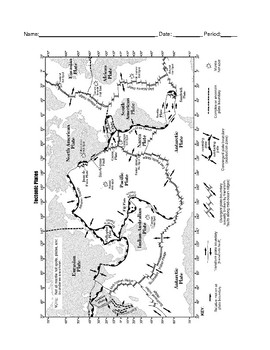
Refer to the Chapter 9 Investigation 9 "Modeling a Plate Boundary" in your Prentice Hall Earth
#1.3.2 practice chronic tectonics manual#
Is the year in which an earthquake occurred an important variable in this investigation? Why orįrom Prentice Hall Earth Science Lab Manual Copyright © 2006 by Pearson Education, Inc. Approximately how far north of this trench are theĪre all of the data points plotted on the graph close to the line of best fit? Provide explanations for Imagine there is a volcanic island arc on the surface of the lithosphere above the area where theĭescending plate has a depth of 100 km.

Plate descends beneath the upper plate is 52° and is known as the subduction angle. Relationship between the depth and the horizontal distance. The triangle below shows a side view of the convergent boundary with the correct scale Use this information along with your answer to question 4 to determine how far theĬonvergent boundary descends as it moves 1 km northward. Use the graph above to determine the approximate latitude of the Aleutian trench atĬalculate the slope of the graph to figure out how quickly the convergent boundary descends asĪ change in latitude of 1 degree corresponds to an approximate 111 km distance along a northsouth line. The Aleutian trench is located where the two tectonic plates meet at the surface of the How does the graph show that the boundary between the Pacific plate and the North American What is the relationship between the depths of earthquake foci and latitude? Use Figure 1 to answer the following questions. The line is a line of best fit that comes as close as possible to each of theĭata points. Do you see any patterns in the data?įigure 1 shows a graph of location and depth of earthquakes, based upon the information in theĭata Table on page 81. These earthquakes all occurred near the 180° W This Data Table shows the Depths of Foci and Latitudes ofĮarthquakes occurring in the Aleutian Islands. Look at the diagram on page 80 to help you understand how the edges of the Pacific plate and theģ. Plate and the North American tectonic plate, south of the Aleutian Arc of volcanic islands in theĢ. Examine the convergence of the Pacific tectonic Look at the map on Resource 3 in the DataBank. This dry lab accompanies the "Modeling a Plate Boundary Lab" on page 79 of your Prentice Hall Earthġ. You understand the lab procedure so you can interpret the data provided. If you do not have access to a laboratory, use this dry lab data to complete the lab activity. Apex Learning ® and the Apex Learning Logo are registered trademarks of Apex Learning Inc. Any unauthorized copying, reuse, or redistribution Use of this material is subject to Apex Learning's Terms of Use. What caused it to break up after it formed? (4 points)Ĭopyright © 2018 Apex Learning Inc. How did a super-continent form? (2 points)ī.

It is thought that all the continents used to be part of one super-continent.Ī. What information did Wegener not have that would have strengthened his argument? (3 points)ħ.

What was the main counterargument against Wegener's evidence? (2 points)ī. Wegener’s theory of continental drift was not accepted by all scientists.Ī. What are four pieces of evidence Alfred Wegener used to support his theory of continental drift? (4Ħ. Magma, volcano, and the direction of plate movement. Make sure you label crust, subduction zone, Draw a diagram to assist your explanation. Why do you usually find volcanoes near subduction zones? (5 points)ī. Volcanoes are usually found near subduction zones.Ī. Which is the stronger force behind plate movement? (2 points)Ĥ. What is "slab-push"? Give one example of a slab-push structure. There are alternate explanations for the forces behind plate movement.ī. Fill in the table with information about the different types of boundaries.

Draw a diagram of Earth that labels its mechanical layers on one side and its composition layersĢ. Answer the following questions thoroughly.ġ.


 0 kommentar(er)
0 kommentar(er)
